30 NOVEMBER – 11 DECEMBER 2023
By Fraser Bell
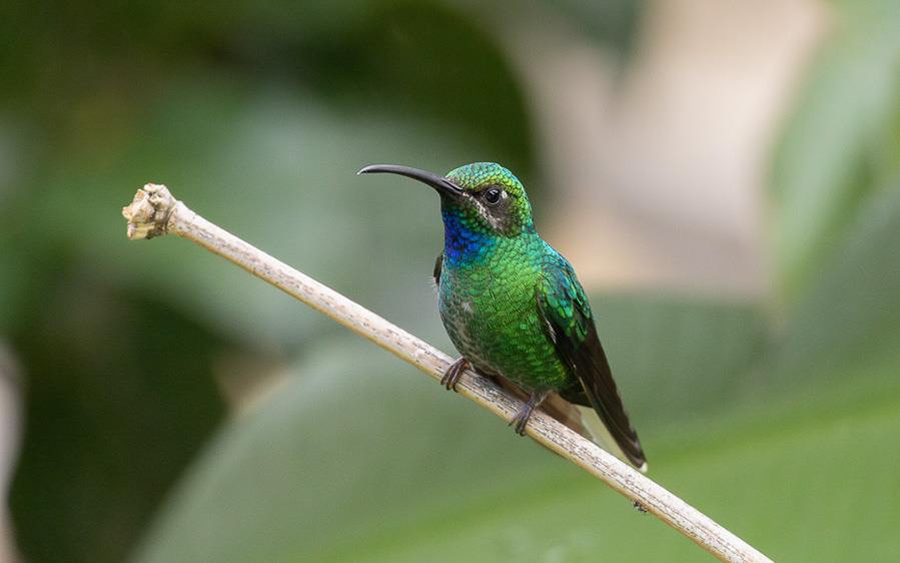
Being only found in Tobago and Venezuela’s Paria Peninsula, White-tailed Sabrewing is a big target on our Trinidad and Tobago bird tour and is always a popular bird.
Overview
This birding tour of Trinidad and Tobago started in Piarco, Trinidad on the 30th of November 2023 and ended in Crown Point, Tobago on the 11th of December 2023. The tour focused on seeing species from a broad range of neotropical bird families, a number of near-endemics and the two true endemics – Trinidad Piping Guan and Trinidad Motmot. On Trinidad we birded at Asa Wright Nature Centre, Trincity Sewage Treatment Pools, Aripo Savannah, Nariva Swamp, Blanchisseuse Road, Orange Valley, Caroni Swamp, and Grand Riviere. While on Tobago we birded at Cuffie River Nature Retreat, Little Tobago Island, Main Ridge Forest Reserve, Centre Street Ponds, Bon Accord Sewage Treatment Ponds, and Tobago Plantation.
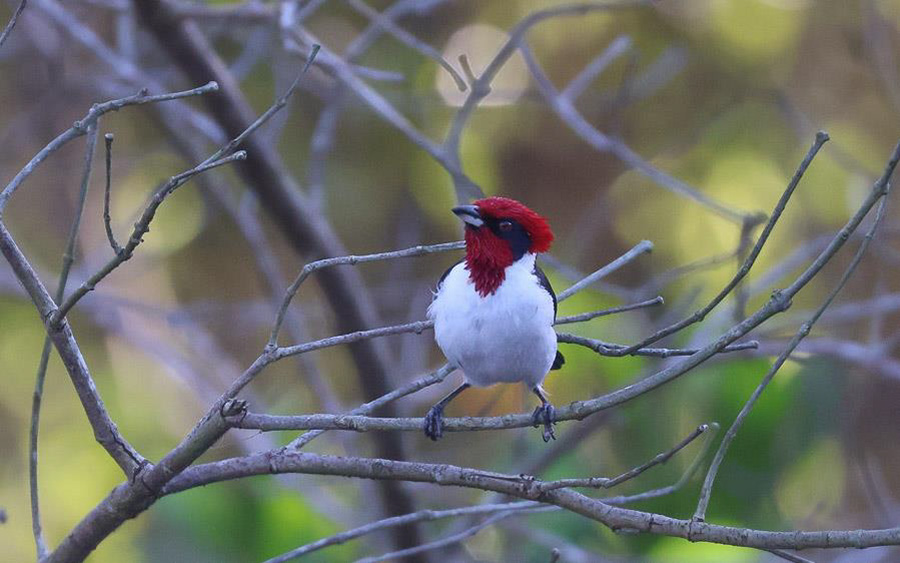
During our birding tour we enjoyed close views of many lovely species, such as this Masked Cardinal which came to investigate our group during our boat trip through the Caroni Swamp.
We recorded 222 bird species on this Trinidad and Tobago birdwatching tour (with nine of these heard only). Some of the highlights seen included Trinidad Piping Guan, American Flamingo, Mangrove Cuckoo, White-tailed Nightjar, Oilbird, Little Hermit, Ruby-topaz Hummingbird, Tufted Coquette, White-tailed Sabrewing, White-chested Emerald, Red-billed Tropicbird, Red-footed Booby, Scarlet Ibis, Spectacled Owl, Guianan Trogon, Trinidad Motmot, American Pygmy Kingfisher, Rufous-tailed Jacamar, Channel-billed Toucan, Bat Falcon, Blue-and-yellow Macaw, Stripe-breasted Spinetail, Blue-backed Manakin, White-bearded Manakin, Golden-headed Manakin, Bearded Bellbird, Venezuelan Flycatcher, Yellow-legged Thrush, Trinidad Euphonia, Masked Cardinal, Speckled Tanager and Bicolored Conebill. In addition to these incredible birds we found a great selection of other wildlife, such as Silky Anteater, Green Turtle, Spectacled Caimen, Ocellated Gecko, Gold Tegu, Common Boa, and Forest Flame. Bird and animal lists for this Trinidad and Tobago birding tour follow the report.
Detailed Report
Day 1, 30th November 2023. Arrival in Trinidad and an introduction to the Asa Wright Nature Centre
The group had arrived into Piarco, Trinidad on the 29th November, allowing an early start to the tour on the 30th November. We met mid-morning and, before transferring to the Asa Wright Nature Centre, we had a quick look at the lakes around the Millenium Lakes Golf Course. This stop gave us lots of wetland species including Wattled Jacana, Osprey, Fork-tailed Palm Swift, Yellow-headed Caracara, Yellow-chinned Spinetail, White-headed Marsh Tyrant, Pied Water Tyrant, White-winged Swallow and we had great close views of Short-tailed Swift which were coming down low to drink from a lake. In the scrub and dry woodland surrounding the lakes and pools we noted our first Rufous-browed Peppershrike, Copper-rumped Hummingbird, Saffron Finch, Spectacled Thrush and Carib Grackle of the trip, alongside a couple of impressive Spectacled Caimen.
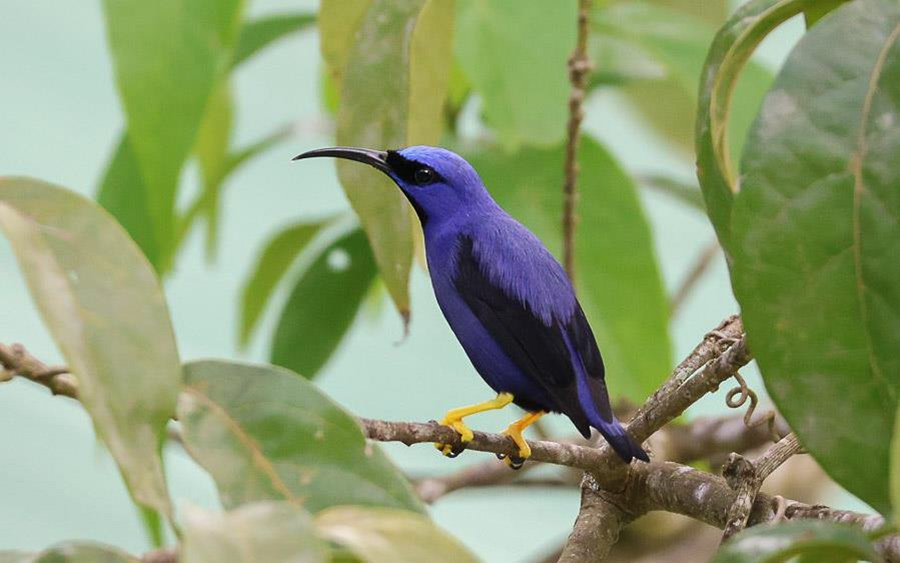
Vibrant Purple Honeycreeper welcomed us to the Asa Wright Nature Centre.
After our lowland birding we made our way to the brilliant Asa Wright Nature Centre. Asa Wright is truly one of the world’s best ecolodges, and everyone thoroughly enjoyed being welcomed to the lodge – it is luxurious, with great food, brilliant facilities, and amazing birdwatching from a comfortable veranda and well-maintained trails. As soon as we arrived we could hear the ‘CLANG’ call of male Bearded Bellbird, and while birding from the veranda we had nine species of hummingbird within the first hour, including White-chested Emerald, Little Hermit, Blue-chinned Sapphire, Black-throated Mango and beautiful Long-billed Starthroat. Other highlights included White Hawk, Channel-billed Toucan, and Crimson-crested Woodpecker in the forest below the veranda, and close views of Turquoise Tanager, Blue Dacnis,and Green and Purple Honeycreepers.
After our lunch we set out on the trails, quickly encountering pairs of both Guianan and Green-backed Trogons, a pair of inquisitive Barred Antshrikes, close views of more than four male Bearded Bellbirds, and we watched several male White-bearded Manakins performing at a lek – a great way to start the tour! We finished our day with a night walk, which although it didn’t turn up any much-wanted owls, we saw a Forest Flame, a Colubrid which hunts other snakes, and an endemic Trinidad Chevron Tarantula.
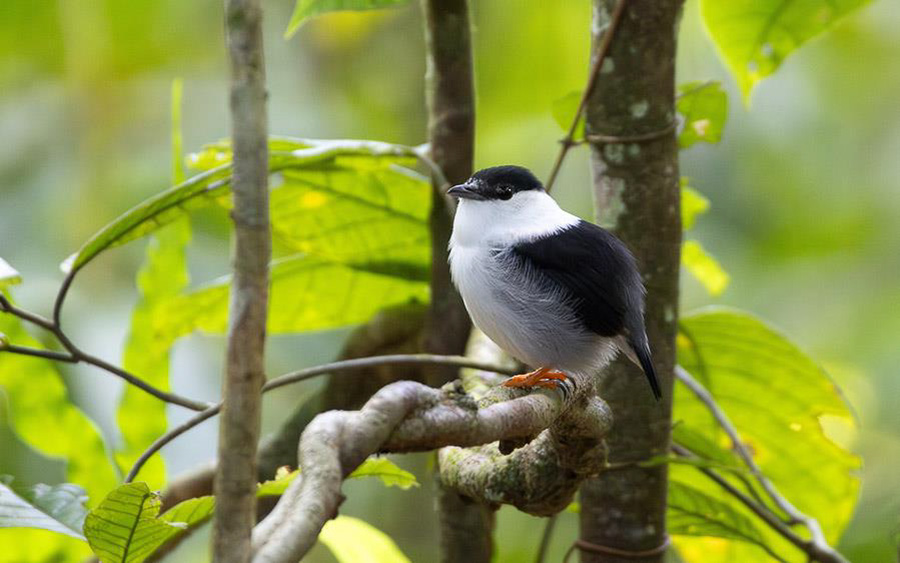
Watching lekking White-bearded Manakins at the Asa Wright Nature Centre was an early tour highlight.
Day 2, 1st December 2023. Birding Aripo Savannah and Nariva Swamp
We spent the morning birding the remains of Trinidad’s savanna, a habitat which is now restricted to the Aripo area. Here we had excellent views of a Striped Cuckoo, which appeared in a roadside bush close to the group before flying up to a high tree to give prolonged scope views. We also had Limpkin, Yellow Oriole, Black-crested Antshrike, Rufous-breasted Wren,and Savanna and Zone-tailed Hawks, among other more common lowland species. A small group of the much-wanted near-endemic Trinidad Euphonia could be heard calling from high in the canopy of a small group of mistletoe trees. These gave us a runaround but eventually the whole group saw a male well as it fed on berries but, frustratingly, these views were brief and far. A fly-by of a Plumbeous Kite – a rare bird in Trinidad – across the savanna, rounded off the morning well.
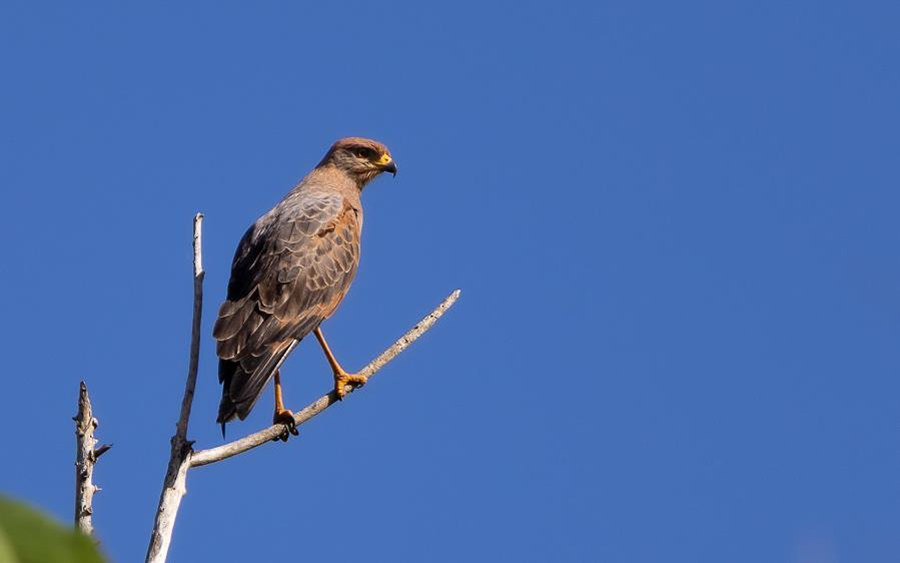
Savanna Hawk was seen well at the Aripo Savanna.
After some excellent Trinidadian food, we stopped at a patch of remnant forest surrounded by farm bush, close to the eastern coast. Although brief, this turned out to be a productive stop! We saw Squirrel Cuckoo, Southern Beardless Tyrannulet,anda cute Streaked Xenops, which showed surprisingly well, before quickly pitching up the branch and into a dense thicket. A pair of Rufous-tailed Jacamar was our only sighting of this species in Trinidad, but the pair were too active for good views, so we would have to wait until Tobago to appreciate these stunners.
Driving south along the eastern coastline we saw many Savanna Hawks and Yellow-headed Caracaras, alongside a surprise juvenile Snail Kite – a rare visitor to Trinidad’s swamps. We spent most of the afternoon birding the mangroves, flooded grassland and marshes of Nariva Swamp, where we saw more than 70 bird species. As soon as we arrived, we had close views of the beautiful American Pygmy Kingfisher along the edge of a thick section of mangrove forest. This charming kingfisher was lovely to watch, as it bobbed its head and pumped its tail on a close mangrove buttress. Northern Scrub Flycatcher and a pair of Bicolored Conebills were also seen here well. Within the swamp itself we had sightings of White-tailed Goldenthroat, Purple Gallinule, Masked Yellowthroat, American Yellow Warbler, Olive-grey Saltator, and at least three Long-winged Harriers as they coursed over the flooded fields. Only as we were about to depart did we hear the distinctive call of one of our main targets for the site, Blue-and-yellow Macaw. After several fleeting glimpses, the whole group managed scope views of several perched birds as they commuted between stands of Moriche Palm. This sighting was followed by a pair of Yellow-crowned Amazons overhead and a perched Pearl Kite, which closed off our second day of birding very well.
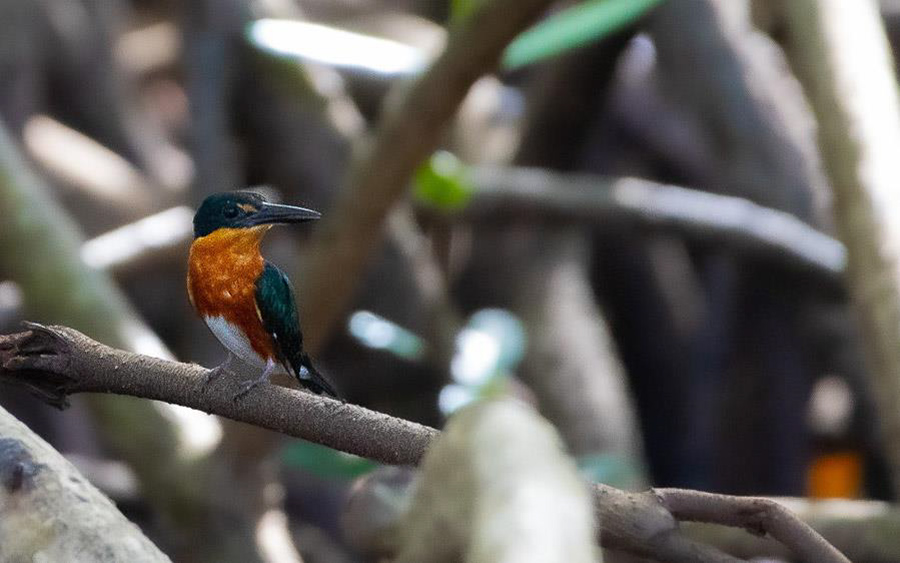
American Pygmy Kingfisher are beautiful birds and we saw this one well in the Nariva Swamp.
Day 3, 2nd December 2023. Birding Trinidad’s northern range along Blanchisseuse Road
We opted for a slower start to the day after our late arrival the previous evening. We enjoyed a leisurely breakfast at Asa Wright while watching Little Hermits and Tufted Coquettes visiting the flowers at the restaurant – it was a joy to watch these stunners feeding so close. Just before departing we saw our first Short-tailed Hawk, this individual was a striking dark morph which circled high over Asa Wright. We then headed north to target high elevation forest specials along Blanchisseuse Road.
On our first stop we had views of Olive-sided Flycatcher perch-flycatching high in the canopy, a perched adult Common Black Hawk and close views of a male White-winged Becard, which turned out to be a group favorite. At times the birding was tough and several spots were ‘neck-breakers’, as forest canopy birding so often is. Despite this, we had good views of Rufous-breasted Hermit, Green-backed Trogon, Golden-fronted Greenlet, Trilling Gnatwren, Red-crowned Ant Tanager, and both White-bearded and Golden-headed Manakins. Our much-anticipated stop at the La Lapaz viewpoint did not yield either of the hoped for hawk-eagle species, instead we enjoyed a White Hawk in the canopy below. Soon after, we found a busy mixed flock which excitingly contained both Golden-crowned Warbler and one of our main targets, a small-group of Speckled Tanagers. The warbler was sadly only enjoyed by some in the group because a fleet of ten all-terrain vehicles very unexpectedly roared past and scared the warbler back into the forest. Luckily, the tanagers stayed and all the tour participants appreciated these brightly colored birds as they foraged close to the road.
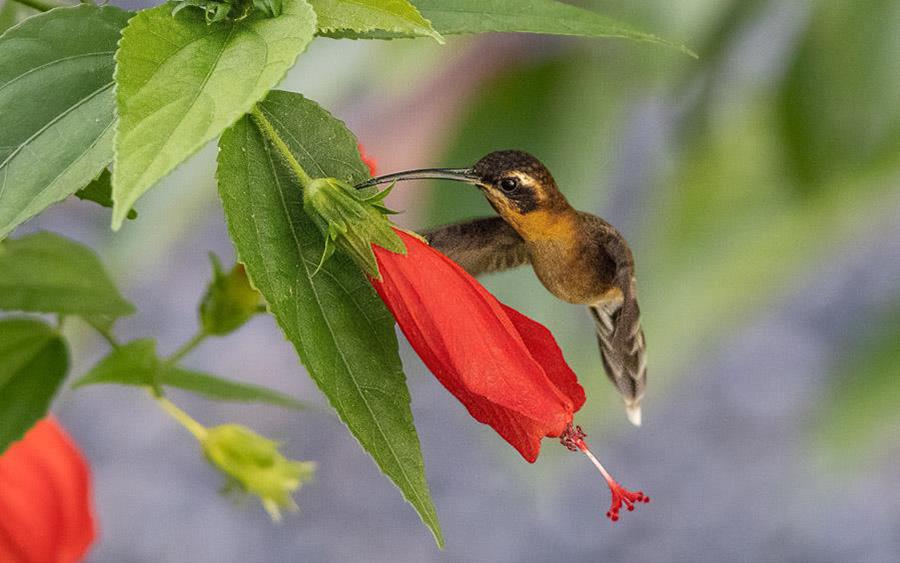
Range-restricted Little Hermits fed in the flowers outside the Asa Wright Nature Centre restaurant every morning.

The whole group enjoyed crippling views of a small foraging party of Speckled Tanager along Blanchisseuse Road.
After a nice local lunch at Brasso Seco village near the northern coast, we headed back along the road towards Asa Wright. Vocal flocks of both Blue-headed Parrots and Lilac-tailed Parrotlets would remain unseen. A small group of Black-tailed Tityras were much enjoyed, as were close views of a cooperative Stripe-tailed Spinetail which flitted around in a fallen tree for the whole group to appreciate. Late afternoon was brilliant for tyrant flycatchers, with Slaty-capped Flycatcher, Yellow-olive Flatbill and Northern Tropical Pewee all seen well, as were a pair of Plain-brown Woodcreepers and a small group of shy and unobtrusive Red-rumped Woodpeckers.
Day 4, 3rd December 2023. Enjoying the Asa Wright Nature Centre
Today we had a whole day to enjoy the Asa Wright Nature Centre, birding from the veranda, around the gardens and trails. A pre-breakfast walk turned up our first sighting of the male Tufted Coquette, a beautiful hummingbird which looks akin to a bee due to its small size and its bumbling flight behavior, and a pair of Lineated Woodpeckers perched on a dead tree. After breakfast we descended into the valley below, in hope of seeing the bizarre Oilbird. Unfortunately, there were no birds roosting in the accessible part of the cave. Instead, we enjoyed a perched Broad-winged Hawk, White-flanked Antwren, another obliging Stripe-breasted Spinetail,a pair of Golden-olive Woodpeckers and active mixed flocks of tanagers and manakins, all while listening to the deafening ‘CLANG’ of the male Bearded Bellbird. We spent the rest of the morning working our way through the swirling flocks of Chaetura swifts, confirming both Grey-rumped and Band-rumped Swifts, and had better views of both Green-backed and Guianan Trogons.
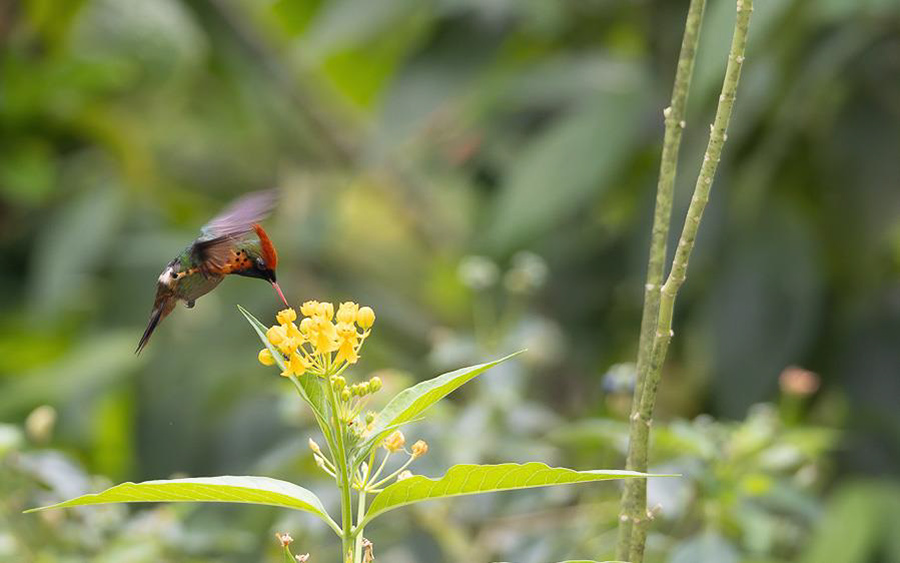
Tufted Coquette are such beautiful birds, this male was feeding in the flowerbed right outside the Asa Wright Nature Centre office.
We spent the first part of the afternoon watching the hummingbirds, honeycreepers, tanagers and Crested Oropendola from the veranda. Later in the afternoon we took a walk down the entrance driveway and enjoyed high bird activity, due to an early afternoon bout of rain. Northern Waterthrush, and White-necked and Cocoa Thrushes were a constant sighting along the road, while Southern Beardless Tyrannulet, Ochre-bellied Flycatcher, and Tropical Parula were found in the canopy – the latter proving tricky and only giving fleeting glimpses. Close views of Cocoa and Plain-brown Woodcreepers were appreciated, while a duo of Red-crowned Ant Tanagers only gave brief views for some. The highlights were a pair of White-bellied Antbird which eventually showed well on some fallen logs and, after hearing them daily, it was great to finally see Collared Trogon! As night fell, some in the group saw an obliging Black-tailed Tityra and the only Short-tailed Nighthawk of the trip, which made a single pass over the canopy below the veranda. Our night walk targeting owls was successful, and all the group had long views of a pair of Spectacled Owls on several occasions. We also heard two Mottled Owl, a rare bird at Asa Wright, although the pair were responsive, they remained in thick cover.
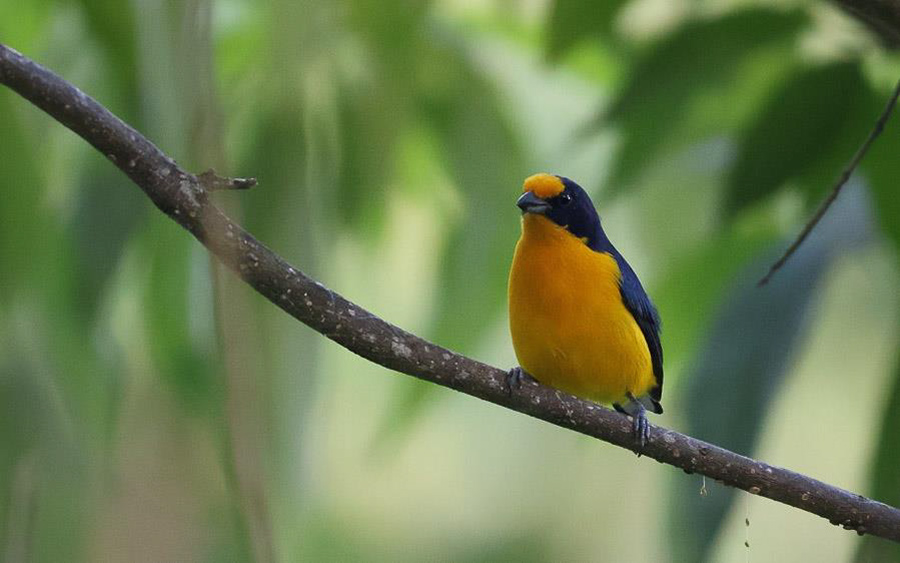
Vibrant Violaceous Euphonias were a common sight from the Asa Wright Nature Centre veranda.
Day 5, 4th December 2023. Birding the west coast of Trinidad and Caroni Swamp
With an early start we departed for the wetlands of western Trinidad, first stopping in on Trincity Sewage Treatment Ponds. On arrival we saw Striped Cuckoo, followed by a fleeting view of a Pearl Kite. Although this one got away from us, it was mediated by another Pearl Kite perched in a roadside tree further along the road. The bird was trying to collect sticks for its nest, but had to cope with Carib Grackle, and a couple of Giant Cowbird mobbing it. Luckily the kite remained in the tree for some time, allowing us to get amazing views of it nestled between some branches. What a great bird! While we were appreciating it, a pair of Yellow Orioles fed in a nearby palm and a flock of Yellow-hooded Blackbirds moved through the maize fields. En route to Orange Valley we saw our only Crested Caracara of the trip, nestled under a tree, but traffic prevented us from stopping to appreciate the bird. The tides were not in our favor when we reached Orange Valley, but we did quickly spy our first (of many hundreds to come) Scarlet Ibis. Once the tide had lowered, a handful of Hudsonian Whimbrels ventured out of the mangroves, alongside a large flock of Willets and Semipalmated Sandpipers. On the moored boats were Ruddy Turnstone, Laughing Gull,and Brown Pelican. The site remained quiet, save for a handful of herons and egrets, an Osprey hunting, and a few American Yellow Warblers on the edge of the mangrove forest, so we headed to lunch.
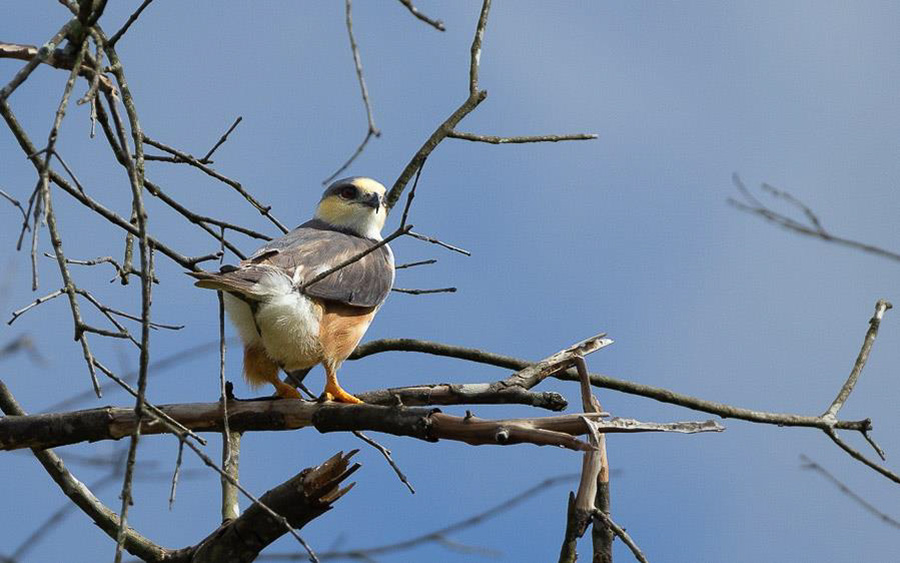
We had great views of this Pearl Kite while it tried to collect nesting material, in spite of harassment from Carib Grackle!
Our local lunch of roti, curry and ice cream was well appreciated, and afterwards we went to Caroni Marsh. This expansive site of protected marsh dominates Trinidad’s western coastline and boasts a number of incredible species. While awaiting our boat ride through the swamp we birded the roadside mangrove edge and were rewarded with a pair of Little Cuckoos. This species specializes in using dense undergrowth and we followed the pair for some time, making do with brief, but good, views between the mangrove roots. Once on the boat we saw a pair of Eared Doves, which are localized on Trinidad (but much more common in Tobago),and a very showy Masked Cardinal which allowed all the passengers of the boat to fully appreciate its smart plumage. Our local guide’s family were influential in the designation and protection of the marsh, our guide – Lester Nanan – grew up studying the species of the marsh and is an expert in spotting its specialist creatures. As such, we were able to see a sleeping Silky Anteater nestled high up in some mangroves, more than four Central American Tree Boas, a pair of roosting Tropical Screech Owls, another obliging American Pygmy Kingfisher, and four Straight-billed Woodcreepers, a mangrove specialist in Trinidad.
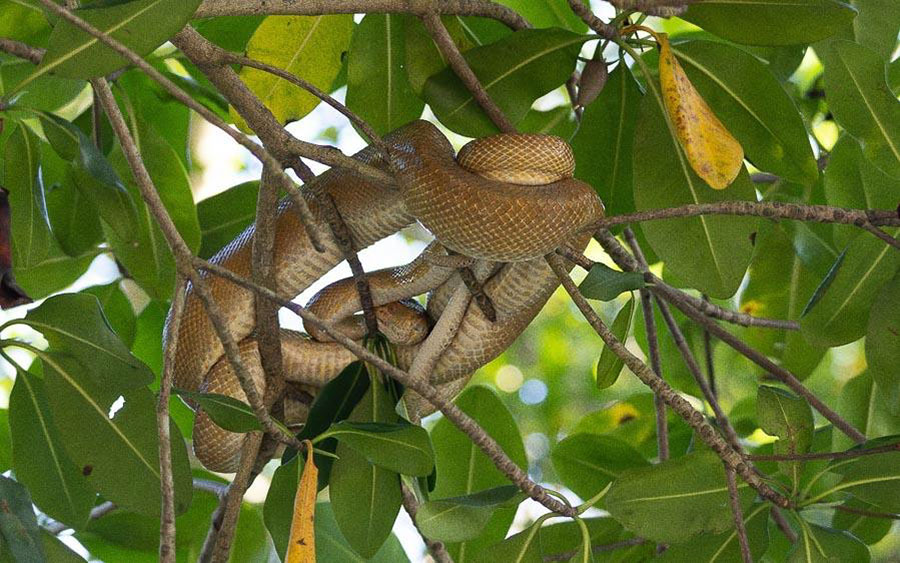
We went directly under this Central American Tree Boa while on our boat tour of the Caroni Swamp, giving some passengers in the boat a bit of a fright.
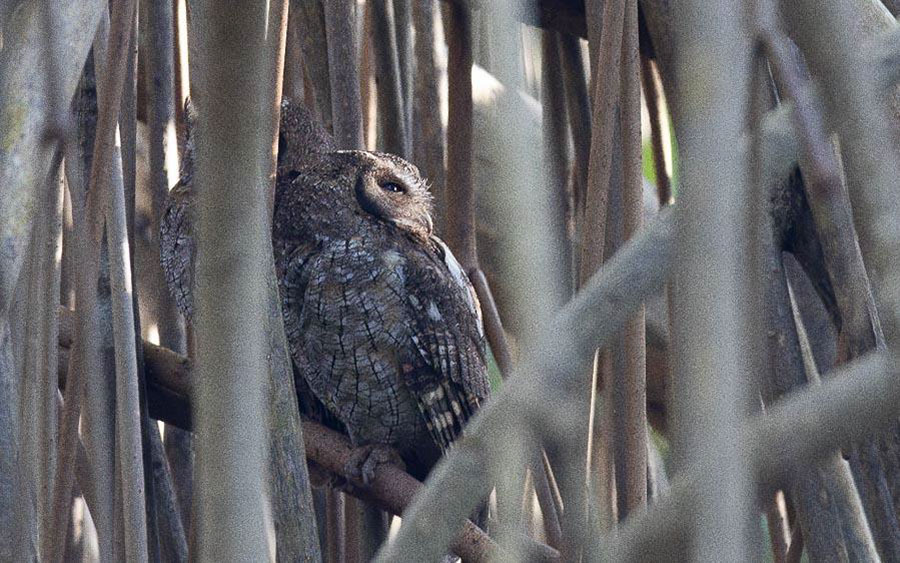
This duo of Tropical Screech Owls was roosting deep in the Caroni Swamp mangroves.
The highlight of the trip for some came as dusk approached. We first saw a group of American Flamingos feeding in a shallow area of the marsh, then watched the spectacle of hundreds of Scarlet Ibises flying in to an isolated island of mangrove, in front of where our boat was moored. These birds had been feeding throughout the expansive marsh during the day, but then come to roost together in large numbers. These ibises were joined by Little Blue, Tricolored, and Great Blue Herons, Great and Snowy Egrets and a handful of American Flamingos. The forested island slowly turns from emerald green to red, white and pink as the birds congregate for the evening. What a brilliant way to spend an evening! On the return boat trip we saw roosting Grey-cowled Wood Rail, and Green Kingfisher and could hear several Common Pauraque.
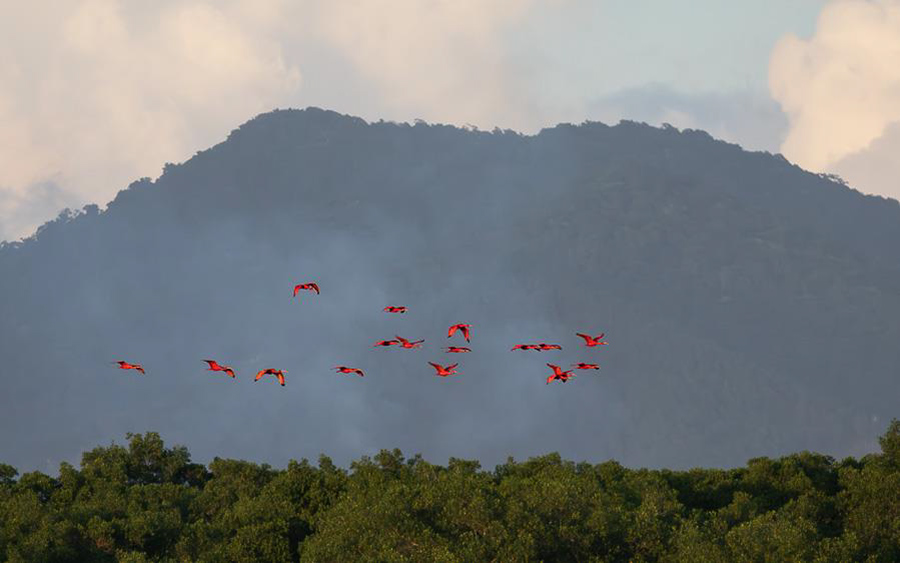
It was a phenomenal experience watching the Scarlet Ibis in the Caroni Marsh.
Day 6, 5th December 2023. A relaxed departure from Asa Wright and transfer to Grand Riviere
We had one final morning at the Asa Wright Nature Centre to focus on any remaining targets. Some in the group hiked back down to Dunstan cave and were rewarded with good views of three Oilbirds! Very satisfying, considering the group had missed them a few days before. On the walk down to the cave the first of our Trinidad Motmots was seen, and this would remain the only sighting in Trinidad, where they are shy and rare. Others decided to try for better views of Bearded Bellbird and to stake out a Golden-headed Manakin lek to try to see an adult male. We were successful with both species, having close views of five male Bearded Bellbirds, which provided good photographic opportunities, and we saw a male Golden-headed Manakin with its striking all-black plumage, and a contrasting bright golden-yellow head. We also tried for Ferruginous Pygmy Owl, but although these were heard throughout our time at Asa Wright, we didn’t see any. Channel-billed Toucans were active with more than seven seen, and we enjoyed our best views of Trilling Gnatwren.
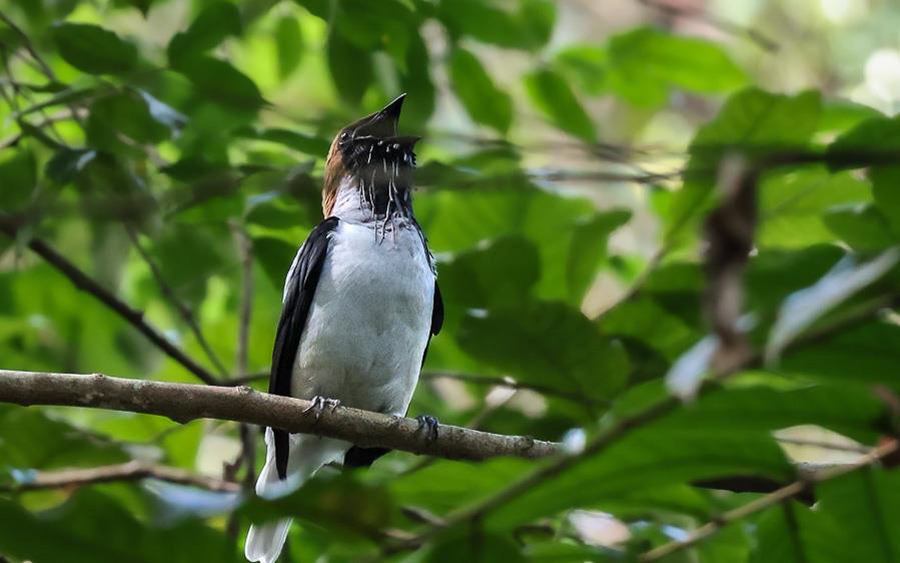
The Asa Wright Nature Centre is one of the best places in the world to see Bearded Bellbird, and our group saw more than five during our stay.
After one final feast, we said our farewells to Asa Wright and headed for Grand Riviere in Trinidad’s northeast. A few well-timed stops yielded our best views of a group favorite, Striped Cuckoo, our first Yellow-rumped Cacique, alongside the near-endemic Trinidad Euphonia, and Rufous-breasted Wren. The afternoon, however, was mostly the transfer and we arrived at our gorgeous beach-front hotel just before dark. We stayed right on the beach and fell asleep to the sound of waves – it was an amazing location to stay at.
Day 7, 6th December 2023. Birding Grand Riviere
We had our earliest start of the tour this morning to ensure we were on the hillside above as dawn broke, to give us the best chance of seeing Trinidad Piping Guan – the rarer of the islands’ two true endemics. Although we had rain on and off throughout the morning, which suppressed activity, the whole group had brilliant views of two Trinidad Piping Guans foraging in the canopy of nutmeg trees. It was a delight watching these birds jumping between the branches, and to hear their whistling calls and mechanical wing churring as they moved between the trees. Due to the rain, little else of note was seen, save for a Grey Kingbird, which is infrequent in Trinidad (again, another species much more common on Tobago), a pair of Trinidad Euphonias, and some in the group saw another beautiful male Golden-headed Manakin. A close encounter with a large Common Boa certainly made for an eventful morning, all were able to fully appreciate it before it vanished back into the undergrowth. We returned for a well-deserved breakfast at our hotel, all ecstatic to have seen such an iconic and rare (Critically Endangered on the IUCN red list) endemic.
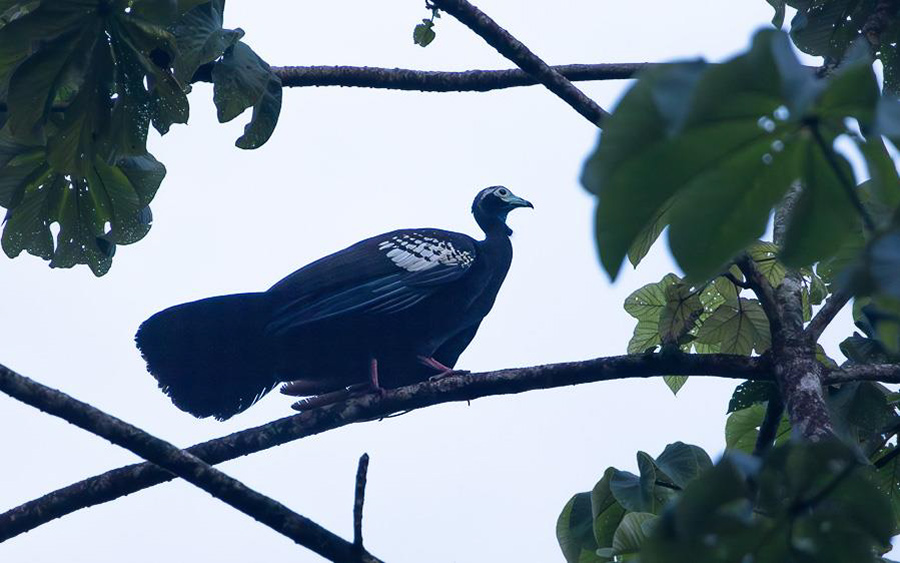
The threatened Trinidad Piping Guan gave us the run around at first, but we ended up seeing eight birds well.
Some of the group checked the lagoon alongside our hotel after breakfast, which yielded our first day time views of Green Kingfisher, which foraged close to the shore from moored boats, giving great opportunity for photography, along with good views of Great Blue Heron, Magnificent Frigatebird, Brown Pelican, Black Vulture and a hunting Osprey. We had the latter part of the morning and the early afternoon to relax at the beautiful property, which was ideal as the rain was heavy.
After a nice lunch the rain had subsided, so we ventured back out to the hillside above the hotel. Bird activity was much higher in the afternoon and, on arrival, we heard Silvered Antbird and, after a little wait, we all had close views of this real skulker. Again, we saw Trinidad Piping Guan, with more birds seen and closer than during the morning. A vocal Little Tinamou would not venture out from the dense undergrowth, but we had good close views of White-flanked Antwren, White-bellied Antbird, Squirrel Cuckoo, Lineated Woodpecker, and finally the group were able to appreciate a pair of Tropical Parulas which responded to our Ferruginous Pygmy Owl playback. Flyovers of Scaled Pigeon and Grey-headed Kite were brief but seen by all. Late afternoon proved good for flycatchers once again, and we had another Yellow-olive Flatbill, and found both Forest Elaenia and Euler’s Flycatcher, which we’d heard at Asa Wright but did not see. A final stop along the forest road yielded a quick fly-by of a Bat Falcon swooping low over the canopy, a great sighting, but sadly not one that all the group got on.
Day 8, 7th December 2023. Transfer to Tobago
Today was predominately a travel day as we drove from Grand Riviere in Trinidad to the airstrip to fly to Tobago. In the morning, a brief look at the lagoon near our hotel in Grand Riviere produced similar species as the previous day, with the addition of a nice male Ringed Kingfisher perched in some low trees, and a few Semipalmated Sandpiper foraging at the lagoon mouth. We heard a Bat Falcon calling from the forest stretch away from the beach but could not locate it.
Our transfer was efficient, but aside from a few short stops which yielded our best view of Giant Cowbird on a sports field, and more Yellow-rumped Cacique from the roadside, we had little time for birding. We arrived into Tobago in the early evening and checked into our ecolodge.
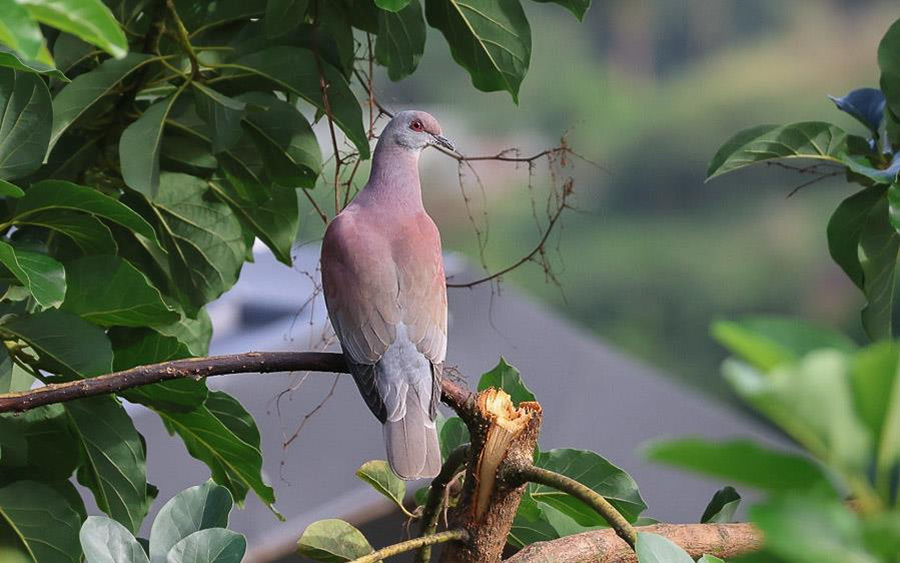
Colourful Pale-vented Pigeon were satisfyingly common on Tobago.
Day 9, 8th December 2023. Exploring Little Tobago Island
Breakfast provided some early highlights, as we quickly saw Red-crowned Woodpecker andmultiple near endemic White-tailed Sabrewing at our ecolodge feeders. As the sabrewings darted around, they would fan their bright white tails which contrasted against their glittering green plumage – such a lovely species to be able to watch. On our trip to the northeast of the island we started seeing the specials which make Tobago such an exciting birding destination. Green Heron replaced the Striated Heron which we’d become used to in Trinidad, Grey Kingbird replaced Great Kiskadee, and Pale-vented Pigeon and Eared Dove were evident along the roadside. In Tobago both Trinidad Motmot and Rufous-tailed Jacamar were wonderfully common, being found along forest edges. We arrived at Tobago’s northeast tip to tropical showery conditions, and had a fairly rough journey to Little Tobago Island, though we were still escorted by Magnificent Frigatebirds. Yet this trip still proved to be a highlight of its own with a Green Turtle seen through the boat’s glass bottom amongst the reefs. On Little Tobago Island we hiked up to the top to enjoy views of nesting Red-billed Tropicbird,and Brown and Red-footed Boobies. We had fun trying to photograph tropicbirds as they soared past and identified the different colour morphs of Red-footed Booby nesting in the surrounding cliffs. Although we had no luck with Scaly-naped Pigeon, a Brown-crested Flycatcher showed well to the whole group and a colorful endemic Ocellated Gecko was enjoyed by all. Following our return journey, we had lunch at one of the best restaurants on Tobago.
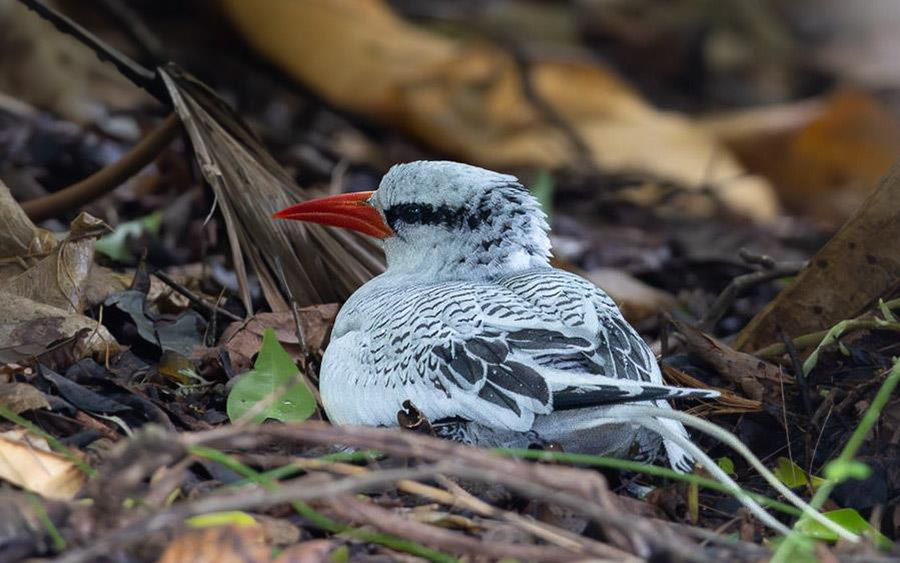
Getting close to nesting Red-billed Tropicbird is often the highlight from Tobago.
We visited a brilliant hummingbird garden and managed to get great views of all six of Tobago’s hummingbird species, which included White-tailed Sabrewing and, importantly, included a beautiful lone male Ruby-topaz Hummingbird – our sole bird of the trip! We also enjoyed close Pale-vented Pigeon, White-tipped Dove, Trinidad Motmot, Red-crowned Woodpecker and Rufous-Vented Chachalaca. During a quiet dinner at our ecolodge, a White-tailed Nightjar flew right past our table, and fed under the security lights – it’s brilliant when the birds come to you.
Day 10, 9th December 2023. Birding Tobago’s Main Forest Ridge Reserve
We had an early departure to visit a known day roost for Common Potoo. After a bit of a search, we found one individual who was surprisingly active and looked back at us. It was quiet at the site, aside from a fishing Green Kingfisher, so we continued to the main Ridge Forest Reserve. This forest is one of the world’s oldest protected nature reserves and dominates the middle of the island. We spent the first few hours within the reserve birding from the roadside, which was very productive, and we added one of our targets with each stop. First was an uncommon Olivaceous Woodcreeper, which provided good viewing as it wound its way along branches of several large trees. A pair of Venezuelan Flycatcher gave fleeting views, but we were nevertheless happy to have seen this range-restricted Myiarchus. Other highlights along the road included a noisy flock of Scrub Greenlets, a Collared Trogon seen in the canopy, and White-tailed Sabrewings foraging on Heliconia in the undergrowth.
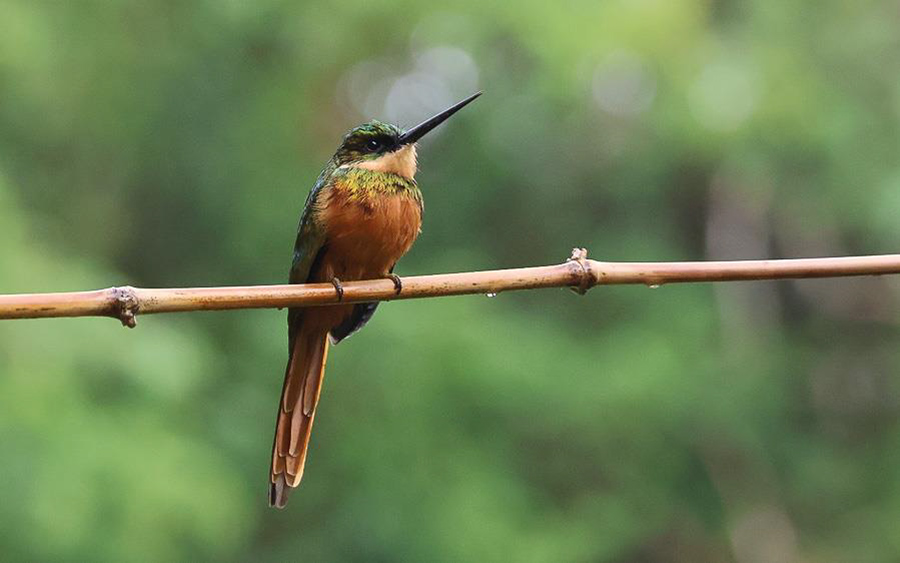
This lovely female Rufous-tailed Jacamar was one of the many we saw along the roadside.
Birding along Gilpin Trace started quietly due to rain, but once this passed, we were able to see most of our remaining forest targets. A perched juvenile Great Black Hawk gave prolonged views, and we watched a Yellow-legged Thrush foraging along an opposing bank. Other highlights included Stripe-breasted Spinetail, Plain Antvireo, and Cocoa Woodcreeper,frustratingly, we only saw female Blue-backed Manakins and only briefly, while a calling White-throated Spadebill did not venture out of the dense forest. Outside the forest we found a pair of Northern White-fringed Antwrens and a Fuscous Flycatcher flittering around a fallen tree, and a single female Red-legged Honeycreeper briefly visited a flowering tree. As we headed back to our ecolodge, we totalled a further 25 Trinidad Motmots and ten Rufous-tailed Jacamars – it’s amazing that these beautiful species are so numerous.
We had the afternoon to relax around the ecolodge and enjoy the grounds, seeing Rufous-vented Chachalaca, Rufous-breasted Hermit, Orange-winged Parrot, Yellow-bellied Elaenia, and Fuscous Flycatcher. That evening we were again joined by White-tailed Nightjar right outside our lodge.
Day 11, 10th December 2023. Exploring the southern wetlands of Tobago
We headed south in the morning to explore Centre Street Ponds, a wetland tucked away just behind the busy streets of Bon Accord. Here we had Blue-winged Teal, White-cheeked Pintail and Lesser Scaup,alongside Least Grebe. We finally had good views of Black-faced Grassquit, while a Black-crowned Night Heron fished along the far bank, with Green Heron. Careful checking of the flock of White-winged Swallow lined up on a telephone wire, added two Sand Martins, a winter visitor to Tobago,to our list. We then continued to Bon Accord Sewage Treatment Ponds, where we were amazingly greeted by nine Soras – these usually secretive birds were walking amongst the floating vegetation, unperturbed by our presence. A large flock of Black-bellied Whistling Ducks were hidden comically amongst the submerged vegetation and only revealed by the tops of their heads, while another Sand Martin was found in with the White-winged Swallows foraging over the pools. In the surrounding vegetation we didn’t find the hoped-for Mangrove Cuckoo, but close views of Brown-crested Flycatcher and Yellow-bellied Elaenia were a consolation prize, meanwhile an aggressive Merlin provided interest as it kept diving onto the far larger Anhinga, forcing them off the wing and into the pools.
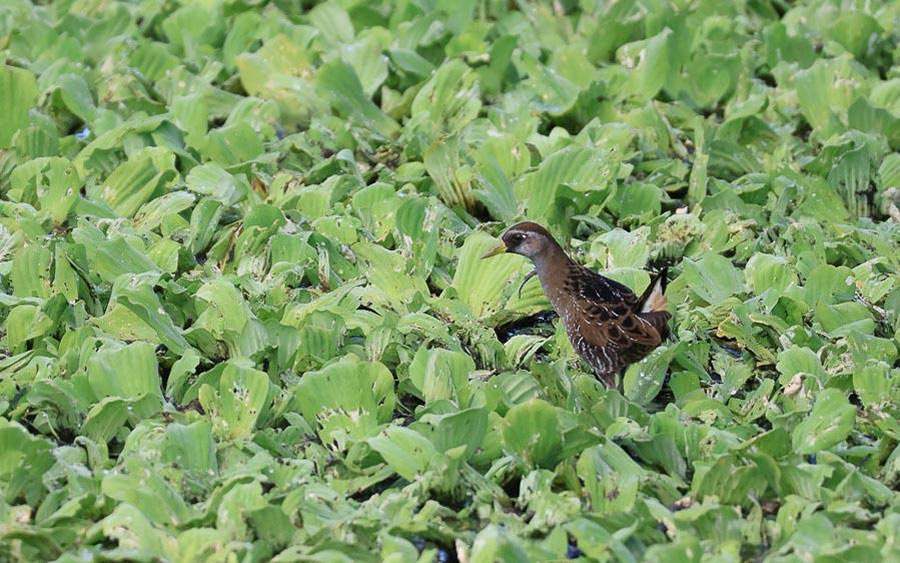
Our group had amazing views of Sora in the open at the Bon Accord Sewage Treatment Ponds.
On leaving the Sewage Treatment Ponds we had nice views of Hudsonian Whimbrel, Green, Tricolored, and Little Blue Herons, Snowy Egret and Lesser and Greater Yellowlegs in the drainage ditches. We then found our rarest bird for the Tobago aspect of the trip – a fishing male Ringed Kingfisher which, although common in Trinidad, is very rare in Tobago. Our third stop of the day was at the Tobago Plantations, where we had Lesser Scaup, Eared Dove and Scrub Greenlet, while several Northern Jacanas tiptoeing across flowering lily pads, created a very beautiful scene. Unfortunately, the mangrove boardwalk was quiet, aside from Central American Tree Boa, Yellow-crowned Night Heron, and Green and Tricolored Herons, yet, on leaving the mangroves, we finally found a Mangrove Cuckoo – a top target for the group. While the views were brief, everyone was able to catch up with this mangrove specialist. After another brilliant local lunch we had Semipalmated Plover, Green-rumped Parrotlet, a single juvenile Lesser Black-backed Gull and enjoyed watching raucous groups of Royal Terns chattering away on the fishing boats.
We headed back to our accommodation, and some saw a roosting American Barn Owl, which unfortunately didn’t stay around for long. Being the final full day of the trip, we enjoyed the beautiful views from our accommodation over the very scenic Castara Bay and finished with an equally lovely meal.
Day 12, 11th December 2023. Departure
With such a beautiful view from our accommodation overlooking the small town of Castara, our final group birdwatching was from the breakfast table itself. We could see groups of Royal Tern bounding across the bay alongside a lone Laughing Gull, and many Brown Pelicans and Magnificent Frigatebirds. From our vantage point we were at a similar height to several large trees, allowing us to fully appreciate noisy groups of foraging Green-rumped Parrotlets and Orange-winged Parrots. Scrub Greenlet and Barred Antshrike hopped around the accommodation gardens and Grey Kingbirds were flycatching from a few high perches. Fittingly, considering it had been voted overall ‘Bird of the Trip’ the previous evening, a few gorgeous and charismatic Trinidad Motmots foraged gracefully in the undergrowth around our hotel.
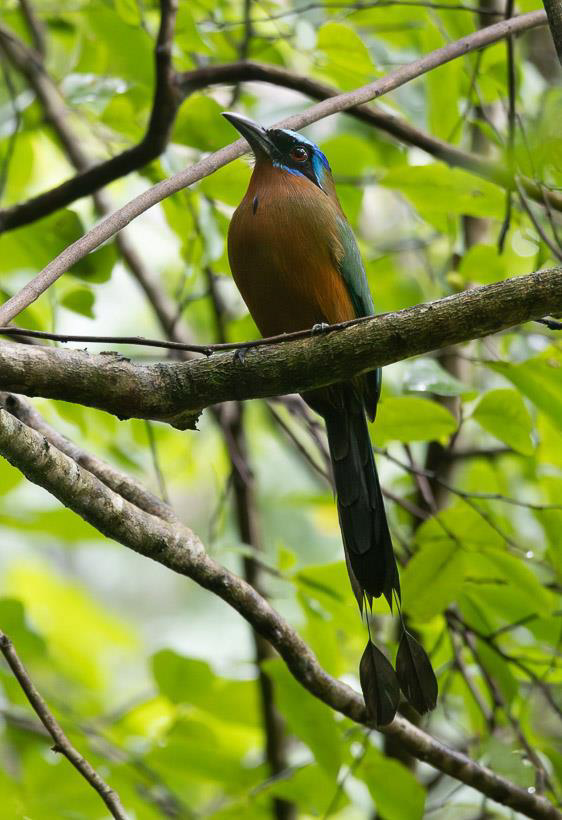
Bird of the trip was the colourful endemic Trinidad Motmot, and for good reason!
Bird List – Following IOC (13.2)
Birds ‘heard only’ are marked with (H) after the common name, all other species were seen. The following notation after species names is used to show conservation status following BirdLife International: CR = Critically Endangered, EN = Endangered, VU = Vulnerable.
| Common Name | Scientific Name |
| Tinamous (Tinamidae) | |
| Little Tinamou (H) | Crypturellus soui |
| Ducks, Geese, Swans (Anatidae) | |
| Black-bellied Whistling-Duck | Dendrocygna autumnalis |
| Blue-winged Teal | Spatula discors |
| White-cheeked Pintail | Anas bahamensis |
| Lesser Scaup | Aythya affinis |
| Guans, Chachalacas, and Curassows (Cracidae) | |
| Rufous-vented Chachalaca | Ortalis ruficauda |
| Trinidad Piping Guan (Endemic) CR | Pipile pipile |
| Flamingos (Phoenicopteridae) | |
| American Flamingo | Phoenicopterus ruber |
| Grebes (Podicipedidae) | |
| Least Grebe | Tachybaptus dominicus |
| Pigeons and Doves (Columbidae) | |
| Rock Pigeon | Columba livia |
| Pale-vented Pigeon | Patagioenas cayennensis |
| Scaled Pigeon | Patagioenas speciosa |
| Ruddy Ground Dove | Columbina talpacoti |
| White-tipped Dove | Leptotila verreauxi |
| Eared Dove | Zenaida auriculata |
| Cuckoos (Cuculidae) | |
| Smooth-billed Ani | Crotophaga ani |
| Striped Cuckoo | Tapera naevia |
| Little Cuckoo | Coccycua minuta |
| Squirrel Cuckoo | Piaya cayana |
| Mangrove Cuckoo | Coccyzus minor |
| Nightjars and Allies (Caprimulgidae) | |
| Short-tailed Nighthawk | Lurocalis semitorquatus |
| Pauraque (H) | Nyctidromus albicollis |
| White-tailed Nightjar | Hydropsalis cayennensis |
| Potoos (Nyctibiidae) | |
| Common Potoo | Nyctibius griseus |
| Oilbird (Steatornithidae) | |
| Oilbird | Steatornis caripensis |
| Swifts (Apodidae) | |
| Grey-rumped Swift | Chaetura cinereiventris |
| Band-rumped Swift | Chaetura spinicaudus |
| Short-tailed Swift | Chaetura brachyura |
| Fork-tailed Palm Swift | Tachornis squamata |
| Hummingbirds (Trochilidae) | |
| White-necked Jacobin | Florisuga mellivora |
| Rufous-breasted Hermit | Glaucis hirsutus |
| Green Hermit | Phaethornis guy |
| Little Hermit | Phaethornis longuemareus |
| Brown Violetear | Colibri delphinae |
| White-tailed Goldenthroat | Polytmus guainumbi |
| Ruby-topaz Hummingbird | Chrysolampis mosquitus |
| Black-throated Mango | Anthracothorax nigricollis |
| Tufted Coquette | Lophornis ornatus |
| Long-billed Starthroat | Heliomaster longirostris |
| White-tailed Sabrewing | Campylopterus ensipennis |
| Copper-rumped Hummingbird | Saucerottia tobaci |
| White-chested Emerald | Chrysuronia brevirostris |
| Blue-chinned Sapphire | Chlorestes notata |
| Rails, Gallinules, and Coots (Rallidae) | |
| Grey-cowled Wood Rail | Aramides cajaneus |
| Sora | Porzana carolina |
| Common Gallinule | Gallinula galeata |
| Purple Gallinule | Porphyrio martinica |
| Limpkin (Aramidae) | |
| Limpkin | Aramus guarauna |
| Plovers and Lapwings (Charadriidae) | |
| Grey Plover | Pluvialis squatarola |
| Southern Lapwing | Vanellus chilensis |
| Semipalmated Plover | Charadrius semipalmatus |
| Jacanas (Jacanidae) | |
| Wattled Jacana | Jacana jacana |
| Sandpipers and Allies (Scolopacidae) | |
| Hudsonian Whimbrel | Numenius phaeopus |
| Ruddy Turnstone | Arenaria interpres |
| Semipalmated Sandpiper | Calidris pusilla |
| Wilson’s Snipe | Gallinago delicata |
| Spotted Sandpiper | Actitis macularius |
| Solitary Sandpiper | Tringa solitaria |
| Greater Yellowlegs | Tringa melanoleuca |
| Willet | Tringa semipalmata |
| Lesser Yellowlegs | Tringa flavipes |
| Gulls, Terns, and Skimmers (Laridae) | |
| Laughing Gull | Leucophaeus atricilla |
| Lesser Black-backed Gull | Larus fuscus |
| Royal Tern | Thalasseus maximus |
| Tropicbirds (Phaethontidae) | |
| Red-billed Tropicbird | Phaethon aethereus |
| Frigatebirds (Fregatidae) | |
| Magnificent Frigatebird | Fregata magnificens |
| Boobies and Gannets (Sulidae) | |
| Brown Booby | Sula leucogaster |
| Red-footed Booby | Sula sula |
| Anhingas (Anhingidae) | |
| Anhinga | Anhinga anhinga |
| Cormorants and Shags (Phalacrocoracidae) | |
| Neotropic Cormorant | Nannopterum brasilianum |
| Pelicans (Pelecanidae) | |
| Brown Pelican | Pelecanus occidentalis |
| Herons, Egrets, and Bitterns (Ardeidae) | |
| Great Blue Heron | Ardea herodias |
| Great Egret | Ardea alba |
| Snowy Egret | Egretta thula |
| Little Blue Heron | Egretta caerulea |
| Tricolored Heron | Egretta tricolor |
| Western Cattle Egret | Bubulcus ibis |
| Green Heron | Butorides virescens |
| Striated Heron | Butorides striata |
| Black-crowned Night Heron | Nycticorax nycticorax |
| Yellow-crowned Night Heron | Nyctanassa violacea |
| Ibises and Spoonbills (Threskiornithidae) | |
| Scarlet Ibis | Eudocimus ruber |
| New World Vultures (Cathartidae) | |
| Black Vulture | Coragyps atratus |
| Turkey Vulture | Cathartes aura |
| Osprey (Pandionidae) | |
| Osprey | Pandion haliaetus |
| Hawks, Eagles, and Kites (Accipitridae) | |
| Pearl Kite | Gampsonyx swainsonii |
| Grey-headed Kite | Leptodon cayanensis |
| Snail Kite | Rostrhamus sociabilis |
| Plumbeous Kite | Ictinia plumbea |
| Long-winged Harrier | Circus buffoni |
| Common Black Hawk | Buteogallus anthracinus |
| Savanna Hawk | Buteogallus meridionalis |
| Great Black Hawk | Buteogallus urubitinga |
| White Hawk | Pseudastur albicollis |
| Grey-lined Hawk | Buteo nitidus |
| Broad-winged Hawk | Buteo platypterus |
| Short-tailed Hawk | Buteo brachyurus |
| Zone-tailed Hawk | Buteo albonotatus |
| Barn Owls (Tytonidae) | |
| American Barn Owl | Tyto alba |
| Owls (Strigidae) | |
| Tropical Screech Owl | Megascops choliba |
| Spectacled Owl | Pulsatrix perspicillata |
| Ferruginous Pygmy Owl (H) | Glaucidium brasilianum |
| Mottled Owl (H) | Strix virgata |
| Trogons (Trogonidae) | |
| Green-backed Trogon | Trogon viridis |
| Guianan Trogon | Trogon violaceus |
| Collared Trogon | Trogon collaris |
| Motmots (Momotidae) | |
| Trinidad Motmot (Endemic) | Momotus bahamensis |
| Kingfishers (Alcedinidae) | |
| Ringed Kingfisher | Megaceryle torquata |
| American Pygmy Kingfisher | Chloroceryle aenea |
| Green Kingfisher | Chloroceryle americana |
| Jacamars (Galbulidae) | |
| Rufous-tailed Jacamar | Galbula ruficauda |
| Toucans (Ramphastidae) | |
| Channel-billed Toucan | Ramphastos vitellinus |
| Woodpeckers (Picidae) | |
| Red-crowned Woodpecker | Melanerpes rubricapillus |
| Red-rumped Woodpecker | Dryobates kirkii |
| Crimson-crested Woodpecker | Campephilus melanoleucos |
| Lineated Woodpecker | Dryocopus lineatus |
| Golden-olive Woodpecker | Colaptes rubiginosus |
| Falcons and Caracaras (Falconidae) | |
| Crested Caracara | Caracara plancus |
| Yellow-headed Caracara | Daptrius chimachima |
| Merlin | Falco columbarius |
| Bat Falcon | Falco rufigularis |
| Peregrine Falcon | Falco peregrinus |
| New World and African Parrots (Psittacidae) | |
| Lilac-tailed Parrotlet (H) | Touit batavicus |
| Blue-headed Parrot (H) | Pionus menstruus |
| Yellow-crowned Amazon | Amazona ochrocephala |
| Orange-winged Amazon | Amazona amazonica |
| Green-rumped Parrotlet | Forpus passerinus |
| Blue-and-yellow Macaw | Ara ararauna |
| Typical Antbirds (Thamnophilidae) | |
| Great Antshrike (H) | Taraba major |
| Black-crested Antshrike | Sakesphorus canadensis |
| Barred Antshrike | Thamnophilus doliatus |
| Plain Antvireo | Dysithamnus mentalis |
| Northern White-flanked Antwren | Myrmotherula axillaris |
| Northern White-fringed Antwren | Formicivora grisea |
| Silvered Antbird | Sclateria naevia |
| White-bellied Antbird | Myrmeciza longipes |
| Ovenbirds and Woodcreepers (Furnariidae) | |
| Olivaceous Woodcreeper | Sittasomus griseicapillus |
| Plain-brown Woodcreeper | Dendrocincla fuliginosa |
| Cocoa Woodcreeper | Xiphorhynchus susurrans |
| Straight-billed Woodcreeper | Dendroplex picus |
| Streaked Xenops | Xenops rutilans |
| Yellow-chinned Spinetail | Certhiaxis cinnamomeus |
| Stripe-breasted Spinetail | Synallaxis cinnamomea |
| Manakins (Pipridae) | |
| Blue-backed Manakin | Chiroxiphia pareola |
| White-bearded Manakin | Manacus manacus |
| Golden-headed Manakin | Ceratopipra erythrocephala |
| Cotingas (Cotingidae) | |
| Bearded Bellbird | Procnias averano |
| Tityras and Allies (Tityridae) | |
| Black-tailed Tityra | Tityra cayana |
| White-winged Becard | Pachyramphus polychopterus |
| Tyrant Flycatchers (Tyrannidae) | |
| White-throated Spadebill (H) | Platyrinchus mystaceus |
| Ochre-bellied Flycatcher | Mionectes oleagineus |
| Slaty-capped Flycatcher | Leptopogon superciliaris |
| Yellow-olive Flatbill | Tolmomyias sulphurescens |
| Ochre-lored Flatbill | Tolmomyias flaviventris |
| Southern Beardless Tyrannulet | Camptostoma obsoletum |
| Forest Elaenia | Myiopagis gaimardii |
| Yellow-bellied Elaenia | Elaenia flavogaster |
| Euler’s Flycatcher | Lathrotriccus euleri |
| Olive-sided Flycatcher | Contopus cooperi |
| Northern Tropical Pewee | Contopus bogotensis |
| Fuscous Flycatcher | Cnemotriccus fuscatus |
| Northern Scrub Flycatcher | Sublegatus arenarum |
| White-headed Marsh Tyrant | Arundinicola leucocephala |
| Pied Water Tyrant | Fluvicola pica |
| Venezuelan Flycatcher | Myiarchus venezuelensis |
| Brown-crested Flycatcher | Myiarchus tyrannulus |
| Great Kiskadee | Pitangus sulphuratus |
| Boat-billed Flycatcher (H) | Megarynchus pitangua |
| Streaked Flycatcher | Myiodynastes maculatus |
| Tropical Kingbird | Tyrannus melancholicus |
| Grey Kingbird | Tyrannus dominicensis |
| Vireos, Shrike-Babblers, and Erpornis (Vireonidae) | |
| Rufous-browed Peppershrike | Cyclarhis gujanensis |
| Scrub Greenlet | Hylophilus flavipes |
| Golden-fronted Greenlet | Pachysylvia aurantiifrons |
| Swallows (Hirundinidae) | |
| Southern Rough-winged Swallow | Stelgidopteryx ruficollis |
| Grey-breasted Martin | Progne chalybea |
| White-winged Swallow | Tachycineta albiventer |
| Sand Martin | Riparia riparia |
| Gnatcatchers (Polioptilidae) | |
| Trilling Gnatwren | Ramphocaenus melanurus |
| Wrens (Troglodytidae) | |
| House Wren | Troglodytes aedon |
| Rufous-breasted Wren | Pheugopedius rutilus |
| Mockingbirds and Thrashers (Mimidae) | |
| Tropical Mockingbird | Mimus gilvus |
| Thrushes and Allies (Turdidae) | |
| Cocoa Thrush | Turdus fumigatus |
| Yellow-legged Thrush | Turdus flavipes |
| White-necked Thrush | Turdus albicollis |
| Spectacled Thrush | Turdus nudigenis |
| Waxbills and Allies (Estrildidae) | |
| Tricolored Munia | Lonchura malacca |
| Common Waxbill | Estrilda astrild |
| Finches, Euphonias, and Allies (Fringillidae) | |
| Trinidad Euphonia | Euphonia trinitatis |
| Violaceous Euphonia | Euphonia violacea |
| Troupials and Allies (Icteridae) | |
| Crested Oropendola | Psarocolius decumanus |
| Yellow-rumped Cacique | Cacicus cela |
| Yellow Oriole | Icterus nigrogularis |
| Shiny Cowbird | Molothrus bonariensis |
| Giant Cowbird | Molothrus oryzivorus |
| Carib Grackle | Quiscalus lugubris |
| Yellow-hooded Blackbird | Chrysomus icterocephalus |
| New World Warblers (Parulidae) | |
| Northern Waterthrush | Parkesia noveboracensis |
| Masked Yellowthroat | Geothlypis aequinoctialis |
| American Redstart | Setophaga ruticilla |
| Tropical Parula | Setophaga pitiayumi |
| American Yellow Warbler | Setophaga petechia |
| Golden-crowned Warbler | Basileuterus culicivorus |
| Cardinals and Allies (Cardinalidae) | |
| Red-crowned Ant Tanager | Habia rubica |
| Tanagers and Allies (Thraupidae) | |
| Masked Cardinal | Paroaria nigrogenis |
| White-lined Tanager | Tachyphonus rufus |
| Silver-beaked Tanager | Ramphocelus carbo |
| Blue-grey Tanager | Thraupis episcopus |
| Palm Tanager | Thraupis palmarum |
| Speckled Tanager | Ixothraupis guttata |
| Turquoise Tanager | Tangara mexicana |
| Bay-headed Tanager | Tangara gyrola |
| Blue Dacnis | Dacnis cayana |
| Purple Honeycreeper | Cyanerpes caeruleus |
| Red-legged Honeycreeper | Cyanerpes cyaneus |
| Green Honeycreeper | Chlorophanes spiza |
| Bicolored Conebill | Conirostrum bicolor |
| Saffron Finch | Sicalis flaveola |
| Blue-black Grassquit | Volatinia jacarina |
| Bananaquit | Coereba flaveola |
| Black-faced Grassquit | Melanospiza bicolor |
| Olive-grey Saltator | Saltator olivascens |
| Total seen | 213 |
| Total heard only | 9 |
| Total recorded | 222 |
Mammal List
| Common Name | Scientific Name |
| Opossums (Didelphidae) | |
| Common Opossum | Didelphis marsupialis |
| Silky Anteater (Cyclopedidae) | |
| Silky Anteater | Cyclopes didactylus |
| Agouti and Acouchis (Dasyproctidae) | |
| Red-rumped Agouti | Dasyprocta leporina |
| Total | 3 |
Reptile and Amphibian List
| Common Name | Scientific Name |
| Sea Turtles (Cheloniidae) | |
| Green Turtle | Chelonia mydas |
| Freshwater Turtles (Geoemydidae) | |
| Spot-legged Wood Turtle | Rhinoclemmys punctularia |
| Alligators and Caimans (Alligatoridae) | |
| Spectacled Caimen | Caiman crocodilus |
| Anoles (Dactyloidae) | |
| Bronze Anole | Anolis aeneus |
| Common Geckos (Gekkonidae) | |
| African House Gecko | Hemidactylus mabouia |
| Iguanas and Chuckwallas (Iguanidae) | |
| Green Iguana | Iguana iguana |
| Neotropical Ground Lizards (Tropiduridae) | |
| Collared Tree Lizard | Plica plica |
| Skinks (Scincidae) | |
| Greater Windward Skink | Copeoglossum aurae |
| Dwarf Geckos (Sphaerodactylidae) | |
| Ocellated Gecko (Endemic) | Gonatodes ocellatus |
| Whiptails (Teiidae) | |
| Giant Ameiva | Ameiva ameiva |
| Amazon Racerunner | Ameiva atrigularis |
| Gold Tegu | Tupinambis teguixin |
| Boas (Boidae) | |
| Common Boa | Boa constricto |
| Central American Tree Boa | Corallus ruschenbergerii |
| Colubrids (Colubridae) | |
| Forest Flame | Oxyrhopus petolarius |
| True Toads (Bufonidae) | |
| Cane Toad | Bufo marinus |
| Cryptic Forest Frogs (Aromobatidae) | |
| Trinidadian Stream Frog (Endemic) | Mmannophryne trinitatis |
| Total | 17 |
This is a sample trip report. Please email us ([email protected]) for more trip reports from this destination.
